Hitler
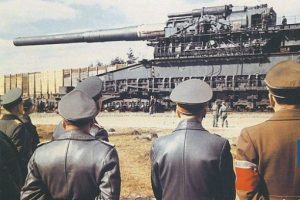 In 1934, Hitler had one problem…the French Maginot Line was the one thing standing in the way of Hitler invading France. In reality, it was the only thing that stood between Hitler and all of Western Europe. The French Maginot Line was a fortification running from the Rhine River to La Ferté consisting of concrete blockhouses, bunkers, and rail lines. The line was elaborate and extensive, and as rumors of its strength made their way to Germany, Hitler began to believe he’d need a miracle for his troops to break through it. Hitler believed that he needed the biggest gun in history.
In 1934, Hitler had one problem…the French Maginot Line was the one thing standing in the way of Hitler invading France. In reality, it was the only thing that stood between Hitler and all of Western Europe. The French Maginot Line was a fortification running from the Rhine River to La Ferté consisting of concrete blockhouses, bunkers, and rail lines. The line was elaborate and extensive, and as rumors of its strength made their way to Germany, Hitler began to believe he’d need a miracle for his troops to break through it. Hitler believed that he needed the biggest gun in history.
Engineers from Krupp, a steel company from Essen, were commissioned by the German High Command (OKH) to design a weapon powerful enough to break through the concrete fortifications that were nearing completion. The shells alone had to be strong enough to penetrate 22 feet of reinforced concrete and at least three feet of steel plating, meaning the weapon had to be massive. It had to be to hold and shoot shells large enough to bring such massive destruction. In order to meet the requirements that Hitler had set forth, Krupp engineer Erich Müller calculated that the weapon would have to be far bigger, and much more powerful than any weapon in existence. After much calculation, Müller put together the measurements for his goliath gun and presented the plan to the OKH.
Though Hitler made no formal commitment, the high command knew the design, known as the Schwerer Gustav, was their answer. With a caliber of 31 inches, able to fire a projectile that weighed more than 10 tons 30 miles away, the Schwerer Gustave was incredibly imposing. The barrel was over 100 feet long, longer than any gun barrel in existence, and the body of the gun was bigger than any tank to see battle so far. It was more like a small building than a gun. From the ground up it was almost four stories tall. It was over 150 feet long including the barrel, and weighed over 1,300 tons. To compare it to things of today, the Space Shuttle weighs 2,000 tons. This was no tiny tank. The shells alone, which had been designed with pure destruction in mind, were taller than two men, twice as wide as one, and weighed 20,000 pounds each. It took several men just to load one into the barrel. For the gun to move around, the body was built on two parallel sets of rail wheels, allowing it to travel across special tracks.
Ultimately, two of these weapons were ordered by the high command, the Schwerer Gustav and a smaller model they called “Dora.” However, the models weren’t ready by the time Hitler was, and the Germans were forced to invade France without them. Of course, they shouldn’t have been worried, as their troops far 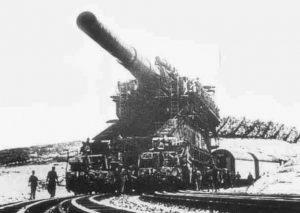 outnumbered the French’s static defenses. Even after the French quickly surrendered, Hitler still wanted to make use of his magnificent and destructive weapon. The siege of Sevastopol was the perfect opportunity. After five weeks of positioning the device, requiring 4,000 men, the weapon was ready. In five days, spanning between June 5 and June 17, the Schwerer Gustav fired 48 rounds, equaling 30,000 tons of ammunition. The barrel of the gun, which had already fired 250 rounds during testing, was worn out entirely. It took 500 men just to fire the gun, and after loading the oversized shells into the machine, they were exhausted. While the gun was daunting to anyone who saw it in action, it really wasn’t very practical.
outnumbered the French’s static defenses. Even after the French quickly surrendered, Hitler still wanted to make use of his magnificent and destructive weapon. The siege of Sevastopol was the perfect opportunity. After five weeks of positioning the device, requiring 4,000 men, the weapon was ready. In five days, spanning between June 5 and June 17, the Schwerer Gustav fired 48 rounds, equaling 30,000 tons of ammunition. The barrel of the gun, which had already fired 250 rounds during testing, was worn out entirely. It took 500 men just to fire the gun, and after loading the oversized shells into the machine, they were exhausted. While the gun was daunting to anyone who saw it in action, it really wasn’t very practical.

 On January 30, 1933, President Hindenburg appointed Adolf Hitler chancellor of Germany. It wasn’t because of any election, but rather by a constitutionally questionable deal dreamed up by a small group of conservative German politicians who had given up on parliamentary rule. Little did they know that they were party to appointing one of the worst dictators in history. Their attempt to return Germany to conservative authoritarian rule, backfired miserably when, within two years, Hitler and the Nazis outmaneuvered Germany’s conservative politicians to consolidate a radical Nazi dictatorship that was completely subordinate to Hitler’s personal will. I wonder if President Hindenburg wished he had never met Hitler, much less appointed him to be chancellor.
On January 30, 1933, President Hindenburg appointed Adolf Hitler chancellor of Germany. It wasn’t because of any election, but rather by a constitutionally questionable deal dreamed up by a small group of conservative German politicians who had given up on parliamentary rule. Little did they know that they were party to appointing one of the worst dictators in history. Their attempt to return Germany to conservative authoritarian rule, backfired miserably when, within two years, Hitler and the Nazis outmaneuvered Germany’s conservative politicians to consolidate a radical Nazi dictatorship that was completely subordinate to Hitler’s personal will. I wonder if President Hindenburg wished he had never met Hitler, much less appointed him to be chancellor.
Within days of taking power, the Nazis called for Germany to boycott all Jewish businesses. This unexpected anti-Jewish propaganda was the first of many. Hitler hated the Jewish people. He had no reason for his hatred. The Jewish people had done nothing to warrant Hitler’s hatred and rage. One theory is that Hitler had decided that the Jewish people were an inferior race. That is not such a new thought. It had happened before, to the African slaves in history, who had often been referred to as mud people. The Jews, as with the slaves, were treated horribly.
Another reason Hitler hated the Jewish people, was because following Germany’s loss of World War I, Hitler blamed the Jews and the communists living in Germany. He felt that they were part of a huge conspiracy against the German military. He believed that had it not been for their interference, Britain and the allies would have lost the war. Another possible reason for Hitler’s hatred of the Jews was probably jealousy. After World War I, he saw that a lot of Germans were without jobs and struggling. Instead of looking at the war as the root cause of the economic problem, he blamed the Jews for the sorry state of affairs. Because Adolf Hitler was truly insane, I’m sure that his reason to hate the Jewish people made sense to him, but the reality is that his insane mind was the only place that it made sense.
I’m not sure how he managed to get so many people to agree with is ideas, but somehow he did, and when he decided that all Jewish shops were to be boycotted, and stationed his SA Storm Troopers near the shops to 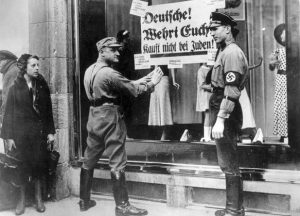
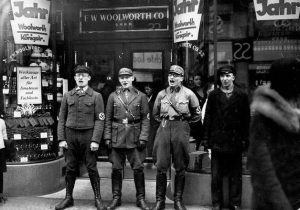
ensure that his plans were carried out, they did as they were told. It wasn’t long after the boycotting of the shops that Hitler took things to the next level, and began hauling the Jewish people to the death camps. As long as he was alive, there was no end to his hatred, and that is definitely not what President Hindenburg or the conservative German politicians had in mind, and I’m sure they wished they had never done it.
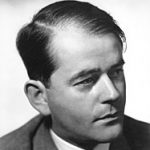
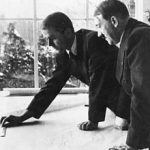 As the chief architect and minister for armaments and war production, Albert Speer designed many of the great buildings that Hitler craved. Hitler loved having the very best. Hitler was always impressed by academic credentials and any kind of artistic or technical talent, so he made Speer his personal architect. Albert Speer was born March 19, 1905, in Mannheim, Germany. At the age of 22, he received his architectural license, having studied at three German technical schools. He became an ardent Nazi after hearing Hitler speak at a rally in late 1930, and joined the party in January 1931. It was his decision to become a Nazi that gave him the opportunity to be noticed by Hitler.
As the chief architect and minister for armaments and war production, Albert Speer designed many of the great buildings that Hitler craved. Hitler loved having the very best. Hitler was always impressed by academic credentials and any kind of artistic or technical talent, so he made Speer his personal architect. Albert Speer was born March 19, 1905, in Mannheim, Germany. At the age of 22, he received his architectural license, having studied at three German technical schools. He became an ardent Nazi after hearing Hitler speak at a rally in late 1930, and joined the party in January 1931. It was his decision to become a Nazi that gave him the opportunity to be noticed by Hitler.
It was the fact that he now worked for Hitler, that gave him the power he craved for himself. Hitler began a massive Berlin building program. Among the projects the Fuhrer entrusted Speer with was the design of the parade grounds for the Nuremberg Party Congress in 1934, which Leni Riefienstahl made famous in her famous propaganda film Triumph of the Will. As minister of armaments and munitions, Speer’s job description expanded to include not only armament production and transportation, but also the direction of raw material use and finally the conscription of slave labor, culled from concentration camps, for war material production. On this day, November 21, 1941, Speer approached Hitler, and asked for 30,000 Soviet prisoners to be slave labor for his projects,telling Hitler that these slave laborers would come in handy for his “new” Berlin. Speer wanted to begin construction even as the war waged. Despite the drain on resources Hitler agreed. Speer beguiled the Fuhrer with models of a Great Hall for the Chancellery and a grand office for Goering. I find it strange to think that someone finally pulled a few things over on Hitler, who always seemed to have the upper hand.
The program was going well, but the times were not in Speer’s favor, or Hitler’s. The war turned against Nazi Germany, the rebuilding plans were scrapped. When the war was over, Hitler was dead by his own hand, and Speer was tried as a war criminal at Nuremberg, the site of his grand parade, and sentenced to 20 years in prison for his role in the Nazi regime, principally for the use of forced labor. Despite repeated attempts to gain early release, he served his full sentence, most of it at Spandau Prison in West Berlin. Following his release in 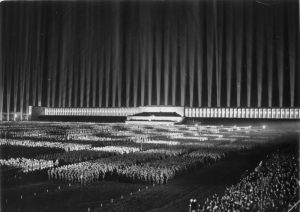
 1966, Speer published two bestselling autobiographical works, Inside the Third Reich and Spandau: The Secret Diaries, detailing his close personal relationship with Hitler, and providing readers and historians with a unique perspective on the workings of the Nazi regime. He wrote a third book, Infiltration, about the SS. Speer died of a stroke in 1981 while on a visit to London.
1966, Speer published two bestselling autobiographical works, Inside the Third Reich and Spandau: The Secret Diaries, detailing his close personal relationship with Hitler, and providing readers and historians with a unique perspective on the workings of the Nazi regime. He wrote a third book, Infiltration, about the SS. Speer died of a stroke in 1981 while on a visit to London.
 Everyone knows the horrors of the Nazi regime, but few people can say that while they thought it was all a part of war, until one day they were forced to see it for what it really was…horrible. These soldiers honestly thought that the concentration camps were no different than the prisoner of war camps they were in, but when they saw the truth, it made them sick. They were forced to face the awful truth that their leader was a complete monster…and worse yet, that they could do nothing to stop his tirade. This forced confrontation brought Germans face-to-face with the worst works of the Third Reich. I can’t imagine the horror of finding out that human beings were being murdered in the gas chambers. The absolute horror of it shows on the faces of the prisoners of war in the United States camps, as they compared the treatment they received at our hands, to what the Nazis were doing to the Jewish people.
Everyone knows the horrors of the Nazi regime, but few people can say that while they thought it was all a part of war, until one day they were forced to see it for what it really was…horrible. These soldiers honestly thought that the concentration camps were no different than the prisoner of war camps they were in, but when they saw the truth, it made them sick. They were forced to face the awful truth that their leader was a complete monster…and worse yet, that they could do nothing to stop his tirade. This forced confrontation brought Germans face-to-face with the worst works of the Third Reich. I can’t imagine the horror of finding out that human beings were being murdered in the gas chambers. The absolute horror of it shows on the faces of the prisoners of war in the United States camps, as they compared the treatment they received at our hands, to what the Nazis were doing to the Jewish people.
An important part of keeping moral up in any war is making sure that the people believe that what their nation is doing, is the right thing. To find out that their nation…their leader, Hitler…was involved in the unwarranted killing of human beings, just because these people were a race they did not like, had to have been such a shock…a sickening shock. This forced process was part of the Allied policy known as denazification, which was designed to to purge Germany of the remnants of Nazi rule and rebuild its civil society, infrastructure, and economy. The program included actual visits to nearby concentration camps. Posters displaying dead bodies of prisoners hung in public places, and forced German prisoners of war to view films documenting the Nazis’ treatment of “inferior” people. The German people had to be changed. They had to realize that Hitler’s evil agenda could not continue. The only way to do that was to change the hearts of men. The best way to change the hearts of men is to show them the horrible truth that they have been lied too and taken advantage of.
While such a harsh method designed to facilitate change was necessary, I must think that it was as hard on the Americans as it was on the Germans. I don’t think anyone could easily watch such horrible murders, without feeling something…except maybe Hitler and his serious henchmen. I still believe that the majority of human beings cannot easily stomach blatant hatred, and horrific murder. I can’t say exactly how big an impact the denazification efforts had at that time in history, but I believe that it was huge. The reason is that the German 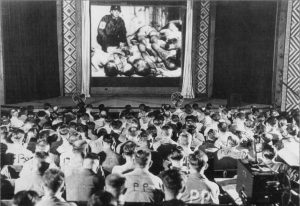 soldiers weren’t necessarily Nazis, and the Holocaust was just one side of the World War II. They were also fighting for territory and power. Strong nationalistic feelings were quite normal back then. Oddly, no conflict existed between not following the Nazis and fighting for the “good of your Fatherland.” Some soldiers were Nazis, some just wanted revenge for Versailles, others wanted to sit at the same table as France and Britain. And many followed because they had no other choice. It was a very strange situation, and one that had to be changed. It may not have been a humane way to bring change, but it was all they could do, so denazification was what they did…and at that time, it worked.
soldiers weren’t necessarily Nazis, and the Holocaust was just one side of the World War II. They were also fighting for territory and power. Strong nationalistic feelings were quite normal back then. Oddly, no conflict existed between not following the Nazis and fighting for the “good of your Fatherland.” Some soldiers were Nazis, some just wanted revenge for Versailles, others wanted to sit at the same table as France and Britain. And many followed because they had no other choice. It was a very strange situation, and one that had to be changed. It may not have been a humane way to bring change, but it was all they could do, so denazification was what they did…and at that time, it worked.
 We have all heard of the atrocities that took place in Nazi Germany regarding the Jewish people. And many people might have seen the movie called Schindler’s List. When the movie came out, I did not have a real interest in the old war movies, but I really should have in this one, because it is not your typical war movie. The movie documents the actions of a member of the Nazi Party, who saw something that was morally wrong, and did something about it.
We have all heard of the atrocities that took place in Nazi Germany regarding the Jewish people. And many people might have seen the movie called Schindler’s List. When the movie came out, I did not have a real interest in the old war movies, but I really should have in this one, because it is not your typical war movie. The movie documents the actions of a member of the Nazi Party, who saw something that was morally wrong, and did something about it.
Schindler wasn’t what would be considered a moral upstanding citizen to the Christian way of thinking. He married Emilie Pelzl at nineteen, but was never without a mistress or two. When his family’s business went under, he presided over the the proceedings, and then became a salesman when opportunity came knocking in the form of the war. Schindler was never one to miss a chance to make money. He saw opportunity in Poland, so he marched in on the heels of the SS. Soon, he was deep into the black-market and the underworld..making friends with the Gestapo officials along the way…softening them up with women, money and illicit booze.

It was his newfound connections that helped him acquire the factory in Krakow during the German occupation of Poland, which he ran with the cheapest labor around…namely the Jewish people from the nearby Jewish ghetto. Schindler was a hard man, and didn’t care much about others, but somewhere along the line, something changed. When the Nazis decided to liquidate the ghetto, he persuaded the officials to allow the transfer of his workers to the Plaszow labor camp. I’m not sure what they workers thought of that situation right away, but in the end, to saved them from deportation to the death camps, for which they were grateful.
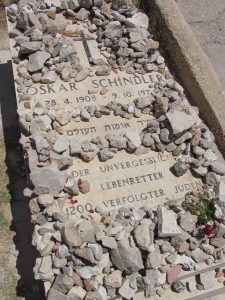
By 1944, Hitler had become more and more crazed, and all the Jews at Plaszow were to be sent to Auschwitz, but Schindler couldn’t bear to see his workers murdered by Hitler. Schindler decided to take a huge risk, and bribe the officials into allowing him to keep his workers and set up a factory in a safer location in occupied Czechoslovakia. Miraculously, they agreed to let him have his workers, probably thinking of the factory’s production, and not the fact that these Jews would not meet the horrible fate awaiting them in the death camps. So, Schindler gave them a list of his workers, and of course, that is where the name of the movie came from. By the war’s end, Schindler was penniless, but he had saved 1,200 Jews. And that makes him a very rich man, indeed. In 1962, he was declared a Righteous Gentile by Yad Vashem, Israel’s official agency for remembering the Holocaust. Oskar Schindler died on this day, October 9, 1974, and according to his wishes, he was buried in Israel at the Catholic cemetery on Mount Zion.
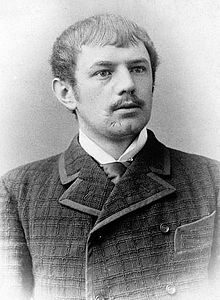 Hitler was undoubtedly one of the most horrible dictators of all time, but what prompted him to become the evil man he was. The story actually begins before Hitler was even born. In 1868, a baby named Dietrich Eckart was born in Neumarkt, Germany, on March 23, the son of a royal notary and law counselor. My guess is that he had a fairly normal childhood…at least until his mother died when he was just ten years old. That may not seem like an event that was unique to Eckart, but somehow it was different, or would become different. Eckart’s life was further complicated when his father died seventeen years later in 1895. At this point, Eckart inherited a considerable sum of money, and started to study medicine in Munich. That would be the last of his somewhat normal life. He spent his father’s money very quickly, and recklessly.
Hitler was undoubtedly one of the most horrible dictators of all time, but what prompted him to become the evil man he was. The story actually begins before Hitler was even born. In 1868, a baby named Dietrich Eckart was born in Neumarkt, Germany, on March 23, the son of a royal notary and law counselor. My guess is that he had a fairly normal childhood…at least until his mother died when he was just ten years old. That may not seem like an event that was unique to Eckart, but somehow it was different, or would become different. Eckart’s life was further complicated when his father died seventeen years later in 1895. At this point, Eckart inherited a considerable sum of money, and started to study medicine in Munich. That would be the last of his somewhat normal life. He spent his father’s money very quickly, and recklessly.
With his money gone, Eckart quit school, and began work as a poet, playwright, and journalist. He moved to Berlin in 1899, where he wrote a number of plays, often with autobiographical traits. Apparently, he was about the only one interested in his plays, because despite becoming the protegé of Graf Georg von Hülsen-Haeseler, the artistic director of the royal theaters, he never was successful as a playwright. Taking his madness one step further, he blamed his failure on society. This was the beginning of the insanity that became Dietrich Eckart. Later on, Eckart developed an ideology of a “genius higher human,” after reading earlier writings by Lanz von Liebenfels. Eckart saw himself like Arthur Schopenhauer and Angelus Silesius, and also became fascinated by Mayan beliefs, but never had much sympathy for the scientific method. That makes sense, because he seemed to want to make up his own truths. Eckart also loved and strongly identified with Henrik Ibsen’s Peer Gynt.
In 1913, when he moved back to Munich, he joined up with Rudolf von Sebottendorff’s right wing Thule Society, and became very politically active. He wrote the nationalist play “Heinrich der Hohenstaufe” (“Heinrich of the High Baptism”), in which he made the claim to world leadership for the German people, craziness that he would eventually pass along to Hitler. Soon he became the editor of the anti-semetic periodical Auf gut Deutsch. Eckart opposed the Treaty of Versailles, which he described as treasonous, and instead spread the so-called Dolchstoßlegende, which stated that the social democrats and Jews were to blame for Germany’s defeat in World War I. He was involved in the founding Deutsche Arbeiterpartei (German Workers’ Party) together with Gottfried Feder and Anton Drexler in 1919, which later on was renamed Nationalsozialistische deutsche Arbeiterpartei (National Socialist German Workers’ Party, NSDAP). He invented and published the NSDAP’s own periodical Völkischer Beobachter, and also wrote the songtext “Deutschland erwache” (Germany awake), which became the anthem of the Nazi party.
Adolf Hitler was born April 20, 1889, just a few years before Eckart’s dad’s passing. During a speech he gave before party members on August 14 1919, Eckart met Adolf Hitler. He exerted considerable influence on Hitler in the following years. Hitler looked at him as his “fatherly friend.” On November 9 1923, Eckart was involved in  the Nazi party’s failed Beer Hall Putsch,as was Hitler. They were arrested and sent to Landsberg prison along with other party officials, but he was released again soon due to illness. He died of a heart attack caused by a morphine addiction in Berchtesgaden on December 26, 1923. Hitler later dedicated the first volume of Mein Kampf to Eckart, and also named the Waldbühne in Berlin “Dietrich-Eckart-Bühne” when it was first opened for the 1936 Summer Olympics. In 1925, Eckarts unfinished essay, Der Bolschewismus von Moses bis Lenin. Zwiegespräch zwischen Hitler und mir (“Bolshevism from Moses to Lenin. Dialogues between Hitler and me”), was posthumously published, although it has been shown that it the dialogues were an invention. The essay was, in fact, written by Eckart alone. I don’t know what Hitler would have been like had e not met Eckart. My guess is that the evil ideas Hitler had were there before their meeting, but I do believe that Eckart had a great influence on Hitler,and probably helped formulate some of the evil that was to come.
the Nazi party’s failed Beer Hall Putsch,as was Hitler. They were arrested and sent to Landsberg prison along with other party officials, but he was released again soon due to illness. He died of a heart attack caused by a morphine addiction in Berchtesgaden on December 26, 1923. Hitler later dedicated the first volume of Mein Kampf to Eckart, and also named the Waldbühne in Berlin “Dietrich-Eckart-Bühne” when it was first opened for the 1936 Summer Olympics. In 1925, Eckarts unfinished essay, Der Bolschewismus von Moses bis Lenin. Zwiegespräch zwischen Hitler und mir (“Bolshevism from Moses to Lenin. Dialogues between Hitler and me”), was posthumously published, although it has been shown that it the dialogues were an invention. The essay was, in fact, written by Eckart alone. I don’t know what Hitler would have been like had e not met Eckart. My guess is that the evil ideas Hitler had were there before their meeting, but I do believe that Eckart had a great influence on Hitler,and probably helped formulate some of the evil that was to come.
 During World War II, it seems that there were a number of missed warnings about coming actions. Perhaps, if these warnings had been heeded, parts of the war, and indeed the length of it might have been different. One such event occurred when two German officers who were flying after consuming too much alcohol, became lost in the inky black night sky, when suddenly their plane began to nosedive. Maybe they thought, as their doomed plane plunged toward the ground, “Please let this be German soil we’re hurtling towards.” No matter what their thoughts were, they were definitely not headed for a crash landing in Germany, but rather they crashed in Holland.
During World War II, it seems that there were a number of missed warnings about coming actions. Perhaps, if these warnings had been heeded, parts of the war, and indeed the length of it might have been different. One such event occurred when two German officers who were flying after consuming too much alcohol, became lost in the inky black night sky, when suddenly their plane began to nosedive. Maybe they thought, as their doomed plane plunged toward the ground, “Please let this be German soil we’re hurtling towards.” No matter what their thoughts were, they were definitely not headed for a crash landing in Germany, but rather they crashed in Holland.
The crash landing in Holland was a big problem for the officers, because they were carrying battle plans for Hitler’s coming invasion of Holland. The plans, which involved exotic strategies like flamethrowers, and using gliders to silently deliver troops behind enemy lines, all seemed so unlikely that the 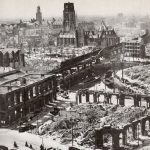 Dutch commanders refused to believe it. Just weeks later, it all unfolded exactly as the plan had foretold. Germany occupied Holland. It seems incredible but almost every daring German offensive was known well beforehand. Yet, in every case, those in power refused to see what was right in front of them. Hitler could have been stopped long before he was, if these botched early warnings had been taken seriously. In another such example, a German deserter was captured by the Russians. He gave up the plans to Hitler’s “Operation Barbarossa.” Yet, the Russian commanders found the 1,800 mile wide offensive too unlikely to believe. Then, just weeks later, they were caught off guard by the largest invasion in history.
Dutch commanders refused to believe it. Just weeks later, it all unfolded exactly as the plan had foretold. Germany occupied Holland. It seems incredible but almost every daring German offensive was known well beforehand. Yet, in every case, those in power refused to see what was right in front of them. Hitler could have been stopped long before he was, if these botched early warnings had been taken seriously. In another such example, a German deserter was captured by the Russians. He gave up the plans to Hitler’s “Operation Barbarossa.” Yet, the Russian commanders found the 1,800 mile wide offensive too unlikely to believe. Then, just weeks later, they were caught off guard by the largest invasion in history.
But, perhaps the most chilling warning of all came far earlier: before the war had even started. The warning came from an analyst dispatched to Hitler’s Germany in 1938. In 1939 he delivered a sobering prediction: the worst conflict in history was about to begin. He reported: “War is coming to Europe, but not until September at the earliest.” On September 1, 1939, Hitler launched his attack on Poland. World  War II had begun. That analyst belonged to a group that soon became part of the largest underground news and research network in the world. One that would go on to predict large world shifts with shocking accuracy: As early as 1987, this network predicted the fall of the Soviet Union. In 1989, they called the crash of the Japanese “miracle.” In the early 90s, they spoke out about the threat of radical Islamic terrorism. In the mid 2000s, they predicted the 2008 financial meltdown. They also predicted Donald Trump’s improbable win in the 2016 Presidential race, which in my opinion was their best prediction. Sadly, this underground news and research group, was not taken seriously in the warnings they gave, and the world paid the consequences for those missed warnings.
War II had begun. That analyst belonged to a group that soon became part of the largest underground news and research network in the world. One that would go on to predict large world shifts with shocking accuracy: As early as 1987, this network predicted the fall of the Soviet Union. In 1989, they called the crash of the Japanese “miracle.” In the early 90s, they spoke out about the threat of radical Islamic terrorism. In the mid 2000s, they predicted the 2008 financial meltdown. They also predicted Donald Trump’s improbable win in the 2016 Presidential race, which in my opinion was their best prediction. Sadly, this underground news and research group, was not taken seriously in the warnings they gave, and the world paid the consequences for those missed warnings.
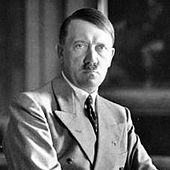 When dealing with one of the world’s more horrible murdering dictators, armies will try just about anything to take them down. Adolf Hitler seemed to be one of those dictators who just couldn’t be taken down. He even flaunted it in the face of his enemies, sending it across the airways, that he was still alive, even after they tried to kill him again. July 21, 1944, was one of those times when Adolf Hitler took to the airwaves to announce that the attempt on his life has failed and that “accounts will be settled.” Not only was Hitler good at dodging a bullet, but he was arrogant too.
When dealing with one of the world’s more horrible murdering dictators, armies will try just about anything to take them down. Adolf Hitler seemed to be one of those dictators who just couldn’t be taken down. He even flaunted it in the face of his enemies, sending it across the airways, that he was still alive, even after they tried to kill him again. July 21, 1944, was one of those times when Adolf Hitler took to the airwaves to announce that the attempt on his life has failed and that “accounts will be settled.” Not only was Hitler good at dodging a bullet, but he was arrogant too.
On this particular day, Hitler had survived the bomb that was meant to take his life. He didn’t get off unscathed, however. Hitler suffered punctured eardrums, some burns and minor wounds, but nothing that would keep him from regaining control of the government and finding the rebels. In fact, it only took a mere 11½ hours, to put down the coup d’etat, that was supposed to accompany the planned assassination of Hitler. In Berlin, Army Major Otto Remer, believed to be apolitical by the conspirators and willing to carry out any orders given him, was told that the Fuhrer was dead and that he, Remer, was to arrest Joseph Goebbels, Minister of Propaganda. But Goebbels had news for Remer.  Hitler was alive. He proved it, by getting him on the phone, because the rebels had forgotten to cut the phone lines. Hitler immediately gave Remer direct orders to put down any army rebellion and to follow only his orders or those of Goebbels or Himmler. Remer obeyed and let Goebbels go. The SS then snapped into action, arriving in Berlin, which was now in chaos, just in time to convince many high German officers to remain loyal to Hitler.
Hitler was alive. He proved it, by getting him on the phone, because the rebels had forgotten to cut the phone lines. Hitler immediately gave Remer direct orders to put down any army rebellion and to follow only his orders or those of Goebbels or Himmler. Remer obeyed and let Goebbels go. The SS then snapped into action, arriving in Berlin, which was now in chaos, just in time to convince many high German officers to remain loyal to Hitler.
What followed forth rebels was hideous. Arrests, torture sessions, executions, and suicides were the order of the day. Count Claus von Stauffenberg, was the man who actually planted the explosive in the room with Hitler. He had insisted to his co-conspirators that “the explosion was as if a 15 millimeter shell had hit. No one in that room can still be alive.” But it was Stauffenberg who would not be alive for much longer. He was shot dead the very day of the attempt by a pro-Hitler officer. There was no trial, and no second chance given. 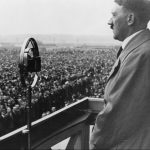 The plot was completely demolished.
The plot was completely demolished.
Then, Hitler set out to restore calm and confidence to the German civilian population. At 1am on July 21, Hitler’s voice broke through the radio airwaves: “I am unhurt and well…. A very small clique of ambitious, irresponsible…and stupid officers had concocted a plot to eliminate me… It is a gang of criminal elements which will be destroyed without mercy. I therefore give orders now that no military authority…is to obey orders from this crew of usurpers… This time we shall settle account with them in the manner to which we National Socialists are accustomed.” The attempt on his life was over, and Hitler would live…to die another day.
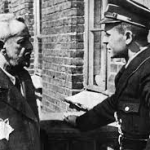
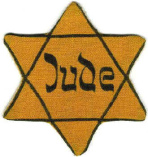 Over the centuries, people have gone to great lengths to humiliate their enemies. The worst thing for the Jewish people was that over the centuries, there have been so many enemies. To this day, it doesn’t matter that Israel is one of the smallest nations in the world, the Muslim nations don’t even want them to have that small area, and the Muslims weren’t the only enemy of the Jewish people either. The Jews of Europe were legally forced to wear badges or distinguishing garments, like pointed hats, to let everyone know who they were. This practice began at least as far back as the 13th century. It continued throughout the Middle Ages and Renaissance, but was then largely phased out during the 17th and 18th centuries. With the coming of the French Revolution and the emancipation of western European Jews throughout the 19th century, the wearing of Jewish badges was abolished in Western Europe.
Over the centuries, people have gone to great lengths to humiliate their enemies. The worst thing for the Jewish people was that over the centuries, there have been so many enemies. To this day, it doesn’t matter that Israel is one of the smallest nations in the world, the Muslim nations don’t even want them to have that small area, and the Muslims weren’t the only enemy of the Jewish people either. The Jews of Europe were legally forced to wear badges or distinguishing garments, like pointed hats, to let everyone know who they were. This practice began at least as far back as the 13th century. It continued throughout the Middle Ages and Renaissance, but was then largely phased out during the 17th and 18th centuries. With the coming of the French Revolution and the emancipation of western European Jews throughout the 19th century, the wearing of Jewish badges was abolished in Western Europe.
Enter Hitler. The Nazis, under Hitler’s direction, resurrected this practice as part of humiliation tactics during the Holocaust. Reinhardt Heydrich, chief of the Reich Main Security Office, first recommended that Jews should wear identifying badges following the Kristallnacht pogrom of November 9 and 10, 1938. Hitler liked the idea, because Hitler hated the Jews. Shortly after the invasion of Poland in September 1939, local German authorities began introducing mandatory wearing of badges. By the end of 1939, all Jews in the newly-acquired Polish territories were required to wear badges. Upon invading the Soviet Union in June 1941, the Germans again required the Jews in the newly-conquered lands to wear badges. Throughout the rest of 1941 and 1942, Germany, its satellite states and western occupied territories adopted regulations stipulating that Jews wear identifying badges. On May 29, 1942, on the advice of Nazi propaganda minister Joseph Goebbels, Adolf Hitler orders all Jews in occupied Paris to wear an identifying yellow star on the left side of their coats. Only in Denmark, where King Christian X is said to have threatened to wear the badge himself if it were imposed on his country’s Jewish population, were the Germans unable to impose such a regulation. Too bad some of the other nations did not stand up for the Jewish people too.
The Yellow Star was imposed on the Jewish people as part of many psychological tactics aimed at isolating and dehumanizing the Jews of Europe and especially by the Nazis. They were being directly marked as being different and inferior to everyone else. It also allowed the Germans to facilitate their separation from society and subsequent ghettoization, which ultimately led to the deportation and murder of 6 million Jews. Those who failed or refused to wear the badge risked severe punishment, including death. For example, the Jewish Council (Judenrat) of the ghetto in Bialystok, Poland announced that “… the authorities have warned that severe punishment – up to and including death by shooting – is in store for Jews who do not wear the yellow badge on back and front.” The star took on different forms in different regions, but everyone in the area knew what it 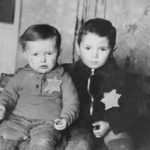
 meant. Of course, the Jewish people hated the badge for what it symbolized, even though the Star of David had stood for the Jewish people since about the 12th century. While the Star of David, known as the Magen David, has continued to be the unofficial symbol of the Jewish people, even on their flag, the Menorah continues to be the official symbol of Judaism (The Jewish people). It seems to me that they would not really want the Star of David after all of the persecution that has been associated with it, but I guess it could be looked at as a badge of honor, as they, as a people survived the persecution.
meant. Of course, the Jewish people hated the badge for what it symbolized, even though the Star of David had stood for the Jewish people since about the 12th century. While the Star of David, known as the Magen David, has continued to be the unofficial symbol of the Jewish people, even on their flag, the Menorah continues to be the official symbol of Judaism (The Jewish people). It seems to me that they would not really want the Star of David after all of the persecution that has been associated with it, but I guess it could be looked at as a badge of honor, as they, as a people survived the persecution.
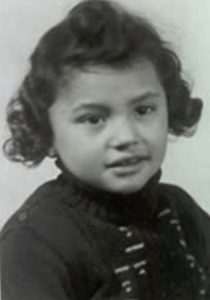 Yesterday, I had the unique opportunity to listen to a Holocaust survivor speak at a seminar. Her name was Inge Auerbacher, and she was an amazing woman. Inge was the last Jewish child born in Kippenheim, a village in South Western Germany located at the foot of the Black Forest. She was the only child of Berthold (1898–1987) and Regina Auerbacher (née Lauchheimer, 1905–1996). Both of her parents came from observant Jewish families who had lived for many generations in Germany. Her father proudly served in the German army, but when the Nazis came for them, his loyal service meant nothing to them. They were Jewish, and that fact condemned them to the concentration camps. Loyal service could not compensate for Hitler’s crazed hatred of the Jewish people.
Yesterday, I had the unique opportunity to listen to a Holocaust survivor speak at a seminar. Her name was Inge Auerbacher, and she was an amazing woman. Inge was the last Jewish child born in Kippenheim, a village in South Western Germany located at the foot of the Black Forest. She was the only child of Berthold (1898–1987) and Regina Auerbacher (née Lauchheimer, 1905–1996). Both of her parents came from observant Jewish families who had lived for many generations in Germany. Her father proudly served in the German army, but when the Nazis came for them, his loyal service meant nothing to them. They were Jewish, and that fact condemned them to the concentration camps. Loyal service could not compensate for Hitler’s crazed hatred of the Jewish people.
Inge had barely started school when her family as deported to Czechoslovakia and sentenced to the Terezin camp. When she and her parents went in, Inge was seven years old when she went into Terezin. She would be there for three years. I will not  say she called it home for three years, because it was definitely not a home. Inge tells of the companions she always knew would be there…the rats, mice, fleas, and bed bugs. The prisoners were allowed two showers a year…yes, I said a year. No wonder those companions hung around. Another occasional companion was lice which meant shaved heads to make removal easier. All of this was horrible, but it was the least of the nightmare. The guards gave brutal beatings…especially the women guards. The scientists performed experiments on the people, and they were given very little to eat. They were doing everything they could to kill their prisoners. Nevertheless, it was all too slow for Hitler.
say she called it home for three years, because it was definitely not a home. Inge tells of the companions she always knew would be there…the rats, mice, fleas, and bed bugs. The prisoners were allowed two showers a year…yes, I said a year. No wonder those companions hung around. Another occasional companion was lice which meant shaved heads to make removal easier. All of this was horrible, but it was the least of the nightmare. The guards gave brutal beatings…especially the women guards. The scientists performed experiments on the people, and they were given very little to eat. They were doing everything they could to kill their prisoners. Nevertheless, it was all too slow for Hitler.
A total of 140,000 people were shipped to Theresienstadt concentration camp near Terezin; 88,000 were sent primarily to the gas chambers in Auschwitz, and 35,000 died of malnutrition and disease in Terezin. Of the 15,000 children imprisoned in 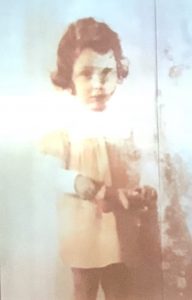 Terezin, Inge and her parents were among the 1% that survived. Her childhood friends, especially her best friend, Ruth lost her life at Auschwitz. Ruth’s father was half Christian and half Jewish. She was raised Christian, but it didn’t make a difference. She and her family were executed for their Jewish heritage. Poor Ruth was deported to Auschwitz in one of the last transports. Ruth and the other children marched with their parents to their final destination, not knowing what was to come. They were told they were going to the showers, but it was the gas chambers, and their parents would not tell them otherwise. It would have been far too cruel. For me, the picture that Inge found years later, of Ruth as a little girl, has stayed vividly in my mind. She was a sweet, innocent little girl, who had done nothing wrong, but her life was taken away from her because she was pat Jewish…because Hitler hated the Jewish people. Hate…an ugly word. Inge says that this type of treatment happens when people lose their humanity. She would tell you, “Never lose your humanity.”
Terezin, Inge and her parents were among the 1% that survived. Her childhood friends, especially her best friend, Ruth lost her life at Auschwitz. Ruth’s father was half Christian and half Jewish. She was raised Christian, but it didn’t make a difference. She and her family were executed for their Jewish heritage. Poor Ruth was deported to Auschwitz in one of the last transports. Ruth and the other children marched with their parents to their final destination, not knowing what was to come. They were told they were going to the showers, but it was the gas chambers, and their parents would not tell them otherwise. It would have been far too cruel. For me, the picture that Inge found years later, of Ruth as a little girl, has stayed vividly in my mind. She was a sweet, innocent little girl, who had done nothing wrong, but her life was taken away from her because she was pat Jewish…because Hitler hated the Jewish people. Hate…an ugly word. Inge says that this type of treatment happens when people lose their humanity. She would tell you, “Never lose your humanity.”

